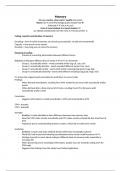Summary
A* Summary Notes on the WHOLE of the MEMORY AQA A Level Psychology
- Course
- Institution
21 page document on ALL YOU NEED TO KNOW FOR MEMORY! <3 A* terminology and quality I achieved an A* using these notes :) ENJOY Huge timer saver and such an effective and concise way to revise!
[Show more]



